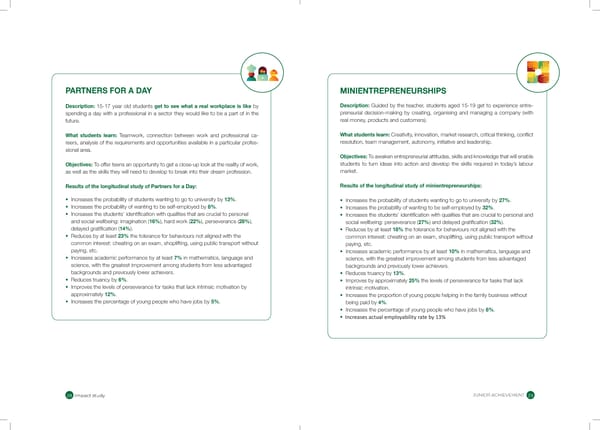PARTNERS FOR A DAY MINIENTREPRENEURSHIPS Description: 15-17 year old students get to see what a real workplace is like by Description: Guided by the teacher, students aged 15-19 get to experience entre- spending a day with a professional in a sector they would like to be a part of in the preneurial decision-making by creating, organising and managing a company (with future. real money, products and customers). What students learn: Teamwork, connection between work and professional ca- What students learn: Creativity, innovation, market research, critical thinking, con ict reers, analysis of the requirements and opportunities available in a particular profes- resolution, team management, autonomy, initiative and leadership. sional area. Objectives: To awaken entrepreneurial attitudes, skills and knowledge that will enable Objectives: To offer teens an opportunity to get a close-up look at the reality of work, students to turn ideas into action and develop the skills required in today’s labour as well as the skills they will need to develop to break into their dream profession. market. Results of the longitudinal study of Partners for a Day: Results of the longitudinal study of minientrepreneurships: • Increases the probability of students wanting to go to university by 13%. • Increases the probability of students wanting to go to university by 27%. • Increases the probability of wanting to be self-employed by 8%. • Increases the probability of wanting to be self-employed by 32%. • Increases the students’ identi cation with qualities that are crucial to personal • Increases the students’ identi cation with qualities that are crucial to personal and and social wellbeing: imagination (16%), hard work (22%), perseverance (28%), 27%) and delayed grati cation (32%). social wellbeing: perseverance ( delayed grati cation (14%). • Reduces by at least 18% the tolerance for behaviours not aligned with the • Reduces by at least 23% the tolerance for behaviours not aligned with the common interest: cheating on an exam, shoplifting, using public transport without common interest: cheating on an exam, shoplifting, using public transport without paying, etc. paying, etc. • Increases academic performance by at least 10% in mathematics, language and • Increases academic performance by at least 7% in mathematics, language and science, with the greatest improvement among students from less advantaged science, with the greatest improvement among students from less advantaged backgrounds and previously lower achievers. backgrounds and previously lower achievers. • Reduces truancy by 13%. • Reduces truancy by 6%. • Improves by approximately 25% the levels of perseverance for tasks that lack • Improves the levels of perseverance for tasks that lack intrinsic motivation by intrinsic motivation. 12%. approximately • Increases the proportion of young people helping in the family business without • Increases the percentage of young people who have jobs by 5%. 4%. being paid by • Increases the percentage of young people who have jobs by 8%. • Increases the probability of wanting to be self-employed by 13%. Increases actual employability rate by 13% Lorem ipsum JUNIOR ACHIEVEMENT ׀׆٪٪UǼȬƇƤɅ٪ȷɅɍƫɬ ׀ׇ
 Junior Achievement Foundation Page 14 Page 16
Junior Achievement Foundation Page 14 Page 16